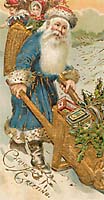
|
THE ARGUMENTS FOR HENRY:
The arguments for Henry as the author of A Visit From St. Nicholas are persuasive.
They range from witnesses telling their children and
grandchildre that they heard the poem read by Henry, to considerations of style. Don Foster's approach to the authorship issue
was to compare the work of three people: Henry Livingston, Clement Moore, and the unknown
author of the Christmas poem. His conclusion: the literary influences on Henry and the unknown
author were almost identical; the influences on Moore completely different.
Smoking Gun?,
First Publication of NBC,
Timeline,
Clement Clark Moore's Poetry
|

|
THE QUEST TO PROVE HENRY'S AUTHORSHIP:
From 1879 on, the Livingston family tried to bring Henry's claim to the public, but their
efforts were unsuccessful. In 1920, William Sturges Thomas took up the quest from his older
relatives with far more success. But though he was
able to make his case public, the public wasn't ready to believe the son of an Episcopalian
archbishop had plagarized a piece of writing. W. Stephen Thomas took up the quest for his
generation, and did convince Vassar President MacCracken, but that still didn't carry weight with
the general public. In 1999, another descendant, Mary Van Deusen, brought the problem to Don Foster,
an expert in attribution of anonymous works.
With Don supplying the direction and the analysis,
Don and Mary the low-level research, and Stephen Livingston Thomas
making available the collected materials he had inherited, Don put a major stake into the ground
for Henry's claim.
|

|
SCHOLARS FOR HENRY:
Jill Farringdon, a British researcher into authorship attribution by a different method than Don Foster's,
subjected the writing of Henry Livingston and Clement Moore to her Cusum analysis.
Her conclusions were that:
1. the anonymous poem had been written by a single author
2. The poem was clearly distinguishable from the utterance of Moore
3. The poem was INDISTINGUISHABLE from the utterance of Major Livingston
|

|
WITNESS LETTERS:
While the world was falling in love with the Christmas poem, Henry's children were teaching their
children that their grandfather had written it. By the time the Livingston family finally learned
that Moore had taken credit for the poem in 1844, it was already 1860, Henry was long dead, and the
original was ashes in a Wisconsin fire. From then on, descendants pooled their memories in the hope
that someday someone could prove the case they didn't know how to prove.
|

|
EARLY TEXT VARIATIONS:
As part of his investigation, Don Foster examined text variations in early publications to see
if Moore's 1844 version owed anything to an earlier editor. And, indeed, it did. The major change
in the poem, the reindeer name rhythm, was actually made by Norman Tuttle, the owner of the
Troy Sentinel.
|

|
SOURCE MATERIALS:
Wherever practically possible, full texts of source materials are available.
You'll find everything from a Clement Moore apologist's brushing off of Henry,
to the defense of Henry's authorship by Dr. Henry Noble MacCracken,
president of Vassar College.
|

|
FICTION:
A fictional account of Henry's writing of the Christmas poem.
|

|
PUBLICITY:
Don Foster's book, Author Unknown, hit the world with the force of a bomb. The New York Times
published a story on the front page of an inside section, and took up a second page, as well. Two page
spreads were the order of the day, from People Magazine to the Washington Post.
|











![]() Copyright © 2003, InterMedia Enterprises
Copyright © 2003, InterMedia Enterprises